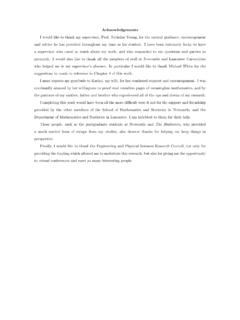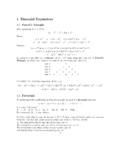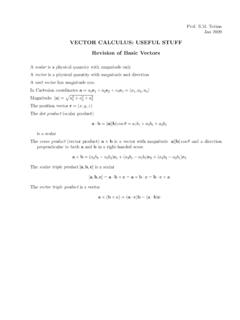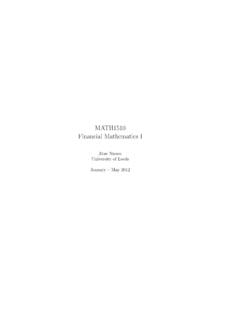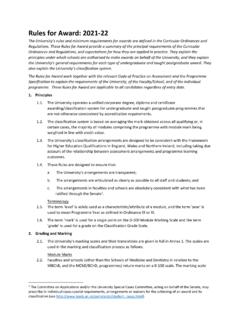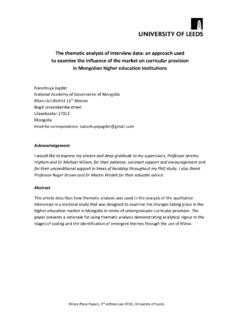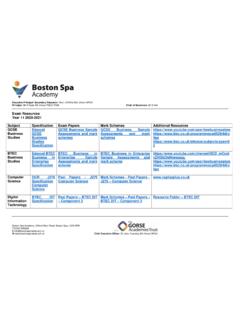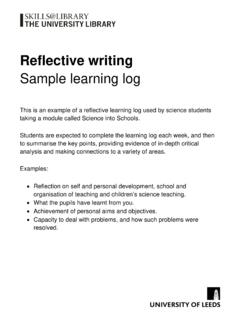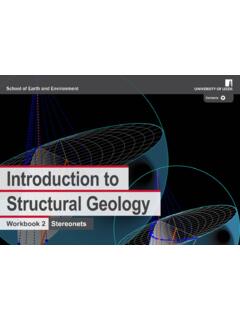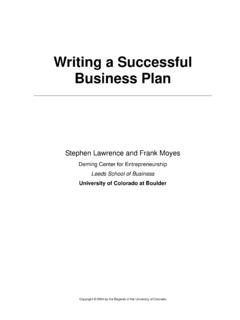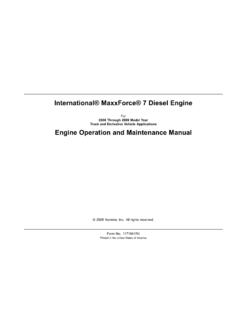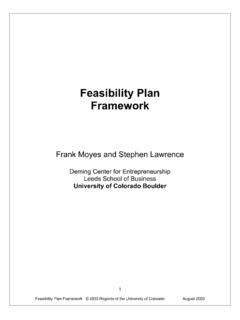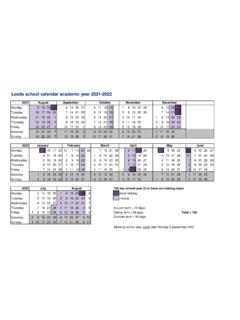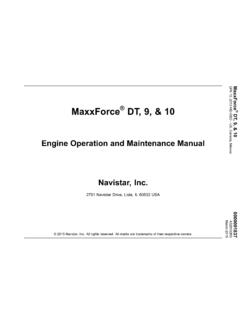Transcription of MATH2620: Fluid Dynamics 1 - maths.leeds.ac.uk
1 MATH2620: Fluid Dynamics 1 School of Mathematics, University of LeedsLecturer:Dr Evy Kersal eOffice:Room , School of MathematicsPhone:0113 343 kersale/2620 Discussion group on the VLE if neededLectures:Tuesday13:00 14:00, Roger Stevens LT 24 Friday12:00 13:00, Roger Stevens LT 24 Workshops:Wednesday [Group 1] 11:00 12:00, Roger Stevens LT 02 Jenny Wong [Group 1] 13:00 14:00, Roger Stevens LT 06 Evy Kersal e [Group 2] 13:00 14:00, Roger Stevens LT 07 Mouloud Kessar Hours:Open door policyAssessment:85% final examination and 15% coursework (10 credits).Textbooks & Picture books: Ruban & Gajjar: Fluid Dynamics . Part 1, Classical Fluid Dynamics , OUP,2014. (Recommended) Bernard, Fluid Dynamics , CUP, 2015.
2 (Recommended) Paterson:A first course in Fluid Dynamics , CUP, 1983. (Recommended) Kundu & Cohen: Fluid mechanics, AP, 2002. (Electronic resource) Acheson:Elementary fluids Dynamics , OUP, 1990. Batchelor:An introduction to Fluid Dynamics , CUP, 2000. (Advanced) M. van Dyke:An album of Fluid motion, Parabolic Press, 1982. M. Samimyet al.:A gallery of Fluid motion, CUP, summary: Fluid Dynamics is the science of the motion of materials that flow, liquid or gas. Under-standing Fluid Dynamics is a real mathematical challenge which has important implicationsin an enormous range of fields in science and engineering, from physiology, aerodynamics,climate, etc., to course gives an introduction to fundamental concepts of Fluid Dynamics .
3 It includes aformal mathematical description of Fluid flows ( in terms of ODEs) and the derivationof their governing equations (PDEs), using elementary techniques from calculus and vectorcalculus. This theoretical background is then applied to a series of simple flows ( bath-plugvortex or stream past a sphere), giving students a feel for how fluids behave, and experiencein modelling everyday wide range of courses, addressing more advanced concepts in Fluid Dynamics , with a varietyof applications (polymers, astrophysical and geophysical fluids, stability and turbulence),follows on naturally from this introductory :This course demonstrates the importance of Fluid Dynamics and how interesting physicalphenomena can be understood using rigorous, yet relatively simple, mathematics.
4 But, it alsoprovides students with a general framework to devise models of real-world problems, usingrelevant theories. Students will learn how to use methods of applied mathematics to deriveapproximate solutions to given problems and to have a critical view on these :Calculus, vector calculus, Outline: Mathematical modelling of fluids. Mass conservation and streamfunctions. Vorticity. Potential flow. Euler s equation. Bernoulli s equation. Flow in an open channel. Lift : You should read through and understand your notes before the next otherwiseyou will get hopelessly lost. Please, do not hesitate to interrupt me whenever you have questions or if I am inaudible,illegible, unclear or just plain wrong.
5 (I shall also stay at the front for a few minutesafter lectures in order to answer questions.) If you feel that the module is too difficult, or that you are spending too much time onit, please come and talk to me. Please, do not wait until the end of term to give a feedback if you are unhappy withsome aspects of the notes: Detailed lecture notes can be downloaded from the module s website. You can print anduse them in the lecture if you wish; however, the notes provided should only be used asa supplement, not as an alternative to your personal notes. These printed notes are an adjunct to lectures and are not meant to be used indepen-dently. Please email me corrections to the notes, examples sheets andmodel sheets & homework: Five example sheets in total to be handed out every fortnight.
6 Examples will help you to understand the material taught in the lectures and will giveyou practice on the types of questions that will be set in the examination. It is veryimportant that you try them before the example classes. There will be only two, yet quite demanding, pieces of coursework (mid and end of termdeadlines). Your work will be marked and returned to you with a grade from 1-100. Model solutions will be distributed once the homework is handed inivContentsNotations11 Mathematical modelling of Introduction .. hypothesis .. field .. Kinematics .. paths .. derivatives ..82 Mass conservation & Conservation of mass: the continuity equation .. Incompressible fluids.
7 Two-dimensional flows .. coordinates .. significance of the streamfunction .. Axisymmetric flows .. streamfunctions .. of Stokes streamfunctions .. 163 Definition .. Physical meaning .. Streamfunction and vorticity .. The Rankine vortex .. Circulation .. Examples of vortex lines (vortices) .. 234 Potential Velocity potential .. Kinematic boundary conditions .. Elementary potential flows .. and sink of Fluid .. vortex .. stream .. (doublet flow) .. Properties of Laplace s equation .. from vector calculus .. of solutions of Laplace s equation .. for an infinite domain.
8 S minimum energy theorem .. Flow past an obstacle .. around a sphere .. half-body .. Method of images .. Method of separation of variables .. 355 Euler s Fluid momentum equation .. acting on a Fluid .. s law of motion .. Hydrostatics .. Archimedes theorem .. The vorticity equation .. Kelvin s circulation theorem .. Shape of the free surface of a rotating Fluid .. 446 Bernoulli s Bernoulli s theorem for steady flows .. Bernoulli s theorem for potential flows .. Drag force on a sphere .. Separation .. Unsteady flows .. in pipes .. oscillations.
9 Acceleration of a sphere .. 577 Steady flows in open Conservation of mass .. Bernoulli s theorem .. Flow over a hump .. Critical flows .. Flow through a constriction .. Transition caused by a sluice gate .. 698 Lift Two-dimensional thin aerofoils .. Kutta-Joukowski theorem .. Lift produced by a spinning cylinder .. Origin of circulation around a wing .. Three-dimensional aerofoils .. 73A Vector Definitions .. Suffix notation .. Vector differentiation .. Differential operators in Cartesian coordinates .. Differential operators polar coordinates .. Vector differential identities.
10 Vector integral theorems .. Alternative definitions of divergence and curl .. Physical interpretation of divergence and curl .. The Divergence and Stokes Theorems .. Conservative vector fields, line integrals and exact differentials .. 80viiiCONTENTSN otationsIn Fluid Dynamics , it is crucial to distinguish vectors from scalars. In these lecture notes weshall represent vectors and vector fields using bold fonts, (x). Other commonlyused notations for vectors include~AorA(used in the lecture). A vectorA, of componentsA1,A2andA3in the basis{ e1, e2, e3}, will interchangeably be written as a column or rowvector,A= A1A2A2 = (A1,A2,A3) =A1 e1+A2 e2+A3 main systems of coordinates will be used throughout to represent points in a threedimensional space, Cartesian coordinates (x,y,z) withx,yandzinR; cylindrical polarcoordinates (r, ,z) withr [0, ), [0,2 ) andz R; and spherical polar coordinates(r, , ) withr [0, ), [0, ] and [0,2 ).]]]]
